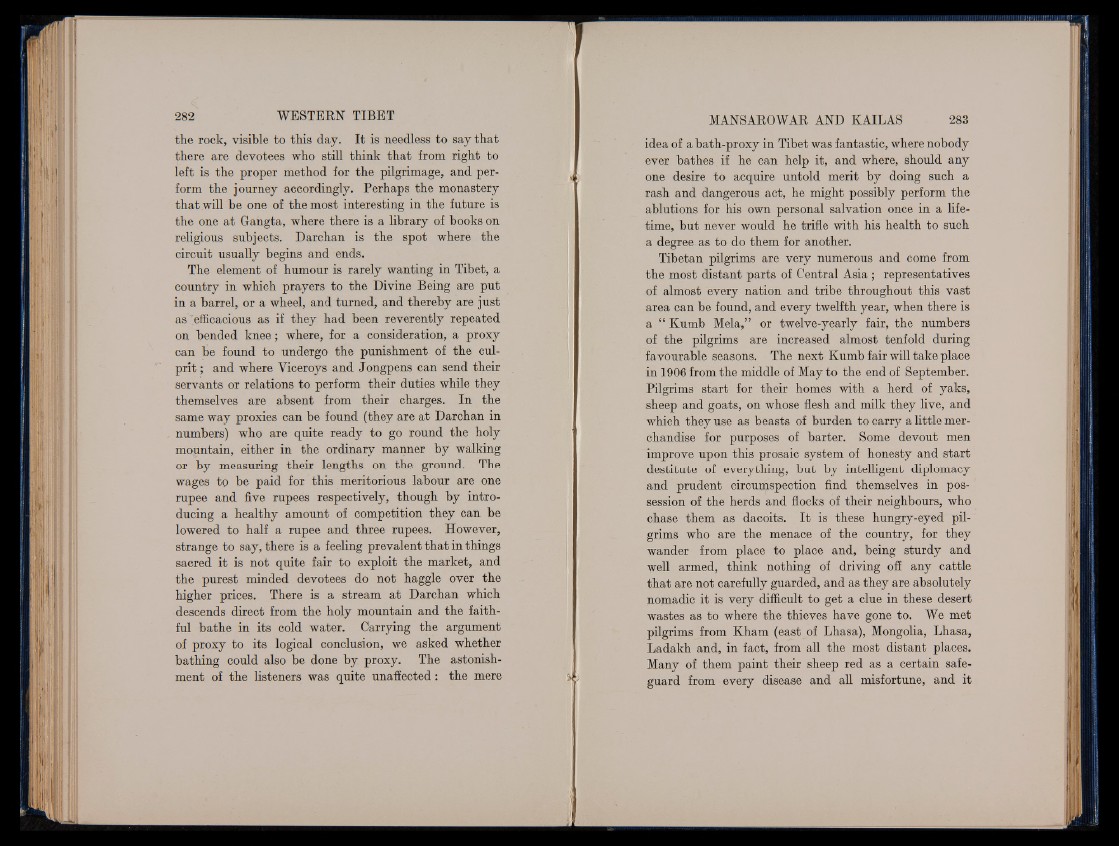
the rock, visible to this day. It is needless to say that
there are devotees who still think that from right to
left is the proper method for the pilgrimage, and perform
the journey accordingly. Perhaps the monastery
that will be one of the most interesting in the future is
the one at Gangta, where there is a library of books on
religious subjects. Darchan is the spot where the
circuit usually begins and ends.
The element of humour is rarely wanting in Tibet, a
country in which prayers to the Divine Being are put
in a barrel, or a wheel, and turned, and thereby are just
as efficacious as if they had been reverently repeated
on bended knee; where, for a consideration, a proxy
can be found to undergo the punishment of the culprit
; and where Viceroys and Jongpens can send their
servants or relations to perform their duties while they
themselves are absent from their charges. In the
same way proxies can be found (they are at Darchan in
numbers) who are quite ready to go round the holy
mountain, either in the ordinary manner by walking
or by measuring their lengths on the ground. The
wages tp be paid for this meritorious labour are one
rupee and five rupees respectively, though by introducing
a healthy amount of competition they can be
lowered to half a rupee and three rupees. However,
strange to say, there is a feeling prevalent that in things
sacred it is not quite fair to exploit the market, and
the purest minded devotees do not haggle over the
higher prices. There is a stream at Darchan which
descends direct from the holy mountain and the faithful
bathe in its cold water. Carrying the argument
of proxy to its logical conclusion, we asked whether
bathing could also be done by proxy. The astonishment
of the listeners was quite unaffected: the mere
idea of a bath-proxy in Tibet was fantastic, where nobody
ever bathes if he can help it, and where, should any
one desire to acquire untold merit by doing such a
rash and dangerous act, he might possibly perform the
ablutions for his own personal salvation once in a lifetime,
but never would he trifle with his health to such
a degree as to do them for another.
Tibetan pilgrims are very numerous and come from
the most distant parts of Central Asia ; representatives
of almost every nation and tribe throughout this vast
area can be found, and every twelfth year, when there is
a “ Kumb Mela,” or twelve-yearly fair, the numbers
of the pilgrims are increased almost tenfold during
favourable seasons. The next Kumb fair will take place
in 1906 from the middle of May to the end of September.
Pilgrims start for their homes with a herd of yaks,
sheep and goats, on whose flesh and milk they live, and
which they use as beasts of burden to carry a little merchandise
for purposes of barter. Some devout men
improve upon this prosaic system of honesty and start
destitute of everything, but by intelligent diplomacy
and prudent circumspection find themselves in possession
of the herds and flocks of their neighbours, who
chase them as dacoits. I t is these hungry-eyed pilgrims
who are the menace of the country, for they
wander from place to place and, being sturdy and
well armed, think nothing of driving off any cattle
that are not carefully guarded, and as they are absolutely
nomadic it is very difficult to get a clue in these desert
wastes as to where the thieves have gone to. We met
pilgrims from Kham (east of Lhasa), Mongolia, Lhasa,
Ladakh and, in fact, from all the most distant places.
Many of them paint their sheep red as a certain safeguard
from every disease and all misfortune, and it